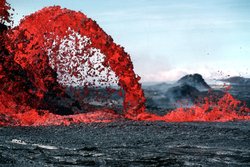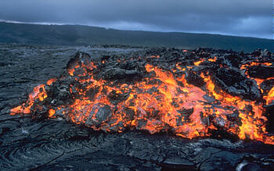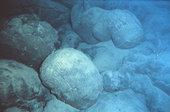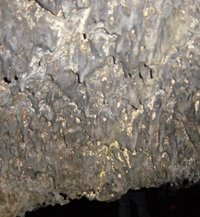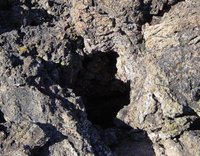Lava
|
|
- For other uses, see Lava (disambiguation).
Lava is molten rock that a volcano expels during an eruption. Lava, when first exuded from a volcanic vent, is a liquid at very high temperature: typically from 700C to 1200C (1300F to 2200F). However, the viscosity of lava is 100,000 times that of water. Nevertheless, the viscous rock can flow many miles before eventually cooling and solidifying.
While still below the earth's surface, the molten rock is termed magma. Solidified lava is known as igneous rock, although the term "lava flow" refers to the hardened formation. An "active lava flow" would be one having still molten rock associated with it. The word 'lava' comes from Italian, and is probably ultimately derived from the Latin word labes which means a fall, slide, or sinking in. The first time it was used in connection with extruded magma was apparently in a short account written by Francesco Serao of the eruption of Vesuvius which took place between May 14 and June 4 1737. In this he described "a flow of fiery lava" in analogy to the flow of water and mud down the flanks of the volcano following heavy rain.
| Contents |
Lava flow types
The three main forms taken by flowing of lava are ‘a‘a, pāhoehoe, and pillow lava.
‘A‘a
Aa or ‘A‘a (Hawaiian English, from Hawaiian: ‘a‘ā meaning "stoney with rough lava", but also to "burn" or "blaze") is one of three basic types of flow lava. ‘A‘a is characterized by a rough or rubbly surface composed of broken lava blocks called clinker.
The loose, broken, and sharp, spiny surface of a solidified ‘a‘a flow makes walking difficult and slow. The clinkery surface actually covers a massive dense core, which was the most active part of the flow. As pasty lava in the core travels downslope, the clinkers are carried along at the surface. At the leading edge of an ‘a‘a flow, however, these cooled fragments tumble down the steep front and are buried by the advancing flow. This produces a layer of lava fragments both at the bottom and top of an ‘a‘a flow. Accretionary lava balls as large as 3 m (10 ft) are common on ‘a‘a flows. ‘A‘a is usually of higher viscosity than pāhoehoe (usually spelled just pahoehoe). Pāhoehoe can turn into ‘a‘a if it becomes turbulent due to meeting impediments or steep slopes.
Missing image Aa_flow_Hawaii.jpg An older ‘a‘a flow, this one on Hualalai in Hawai‘i |
Pāhoehoe
Pahoehoe or Pāhoehoe (Hawaiian English, from Hawaiian, meaning "smooth, unbroken lava") is basaltic lava that has a smooth, hummocky, or ropy surface. A pāhoehoe flow typically advances as a series of small lobes and toes that continually break out from a cooled crust. The surface texture of pāhoehoe flows varies widely, displaying all kinds of bizarre shapes often referred to as lava sculpture.
Missing image Pahoehoe_toe.jpg Closeup of advancing molten "toe" of Pahoehoe | |
 Pāhoehoe lava near Black Crater in Lava Beds NM. |
Pillow lava
Pillow lava is the rock type typically formed when lava emerges from an underwater volcanic vent or a lava flow enters the ocean. The viscous lava gains a solid crust immediately upon contact with the water, and this crust cracks and oozes additional large blobs or "pillows" as more lava emerges from the advancing flow. Since the majority of Earth's surface is covered by water, and most volcanoes are situated near or under it, pillow lava is actually very common.
Lava formations
Lava, being much more viscous than water, tends not to flow as rapidly. Nevertheless, where the slope of the ground is considerable, it can advance with great speed. Even when at its hottest, it is somewhat viscous, like treacle, and this viscosity increases as it cools. Hence, on a level plain, and at some distance from its source, the lava-stream advances at a leisurely pace. In such circumstances the cooling proceeds so quickly that a crust of considerable thickness is soon formed on the top of the current, and persons who are bold enough may cross the stream by means of this natural bridge. Even where a deep interior flow continues, a crust may be formed on the surface; and someone whose curiosity exceeded their prudence could stand on the top of it, bore a hole through the crust, and see the lava flowing underneath their feet!
There are few things not made of rock that can resist the progress of flowing lava; trees, houses, everything yields to its massive assault. Trees soon catch fire due to the heat of approaching lava, and when the lava reaches them they emit a hissing noise, almost amounting to a shriek. The trees then plunge into the molten flood and are seen no more. Even the sea cannot stop the lava-stream, but retires on its approach; promontories stretching a considerable distance from the shore are formed in this manner as the molten lava hardens into stone.
Lava cascades and fountains
The eruptions of lava are sometimes attended by peculiarities which impart to them much additional grandeur. Instances have occurred in which the fiery stream has plunged over a sheer precipice of immense height, so as to produce a glowing cascade exceeding in breadth and perpendicular descent the celebrated Niagara Falls. In other cases, the lava, instead of at once flowing down the sides of the mountain, has been first thrown up into the air as a fiery fountain several hundred feet in height (see Volcanic cone).
Composition of lavas
The lavas of different mountains, when cooled and hardened, differ much in their appearance and composition. If a rhyolite lava-stream comes into contact with water, for example entering the sea, it can quickly freeze into a black glassy substance called obsidian. This is particularly common in Iceland and Lipari. It is used for ornamental purposes - it presents a different appearance according to the manner in which it is cut. When cut in one direction it is of a beautiful jetty black; when cut across that direction it is glistering gray. In prehistoric times its hardness and conchoidal fracture properties meant it was widely used to make knives.
The lavas of Vesuvius are generally of a brown colour, and are also used in the arts. In them are found the beautiful olive-green crystals of the mineral called olivine, sometimes used by jewellers. But the most useful of all volcanic productions is perhaps sulfur, in which Mount Etna has been very prolific.
- See also: Lava tube
Other images
Towns destroyed by lava
Kalapana_house_destroyed_by_lava.jpg
- Kaimū, Hawaii (abandoned)
- Kalapana, Hawaii (abandoned)
- Kapoho, Hawaii (abandoned)
- Keawaiki, Hawaii (abandoned)
- Koa‘e, Hawaii (abandoned)
- San Sebastiano al Vesuvio, Italy (rebuilt)
Towns partially destroyed by lava flows
- Catania, Italy, in the eruption Mount Etna in 1669 (rebuilt)
- Goma, Democratic Republic of Congo, in the eruption of Nyiragongo in 2002
- Heimaey, Iceland, in the 1973 Eldfell eruption (rebuilt)
- Royal Gardens, Hawaii, by the eruption of Kilauea in 1986-87 (abandoned)
External Links
- http://volcanoes.usgs.gov/Products/Pglossary/aa.html
- http://volcanoes.usgs.gov/Products/Pglossary/pahoehoe.htmlda:Lava
de:Lava es:Lava eo:Lafo fa:گدازه fr:Lave id:Lava it:Lava he:לבה lb:Lava nl:Lava ja:溶岩 no:Lava pl:Lawa pt:Lava fi:Laava sv:Lava


